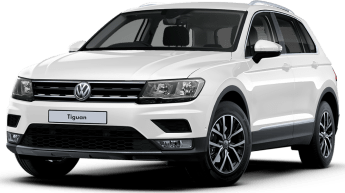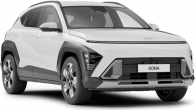Volkswagen is undergoing some changes. Aside from its monumental shift to electrification in its European home market, the brand tells us that now, when people think 'VW', instead of the iconic Golf hatch, they now picture this car, the Tiguan.
The stalwart mid-size SUV is now the German monolith’s best-selling car in Australia by quite a margin. No pressure on this new one then, which arrives initially in the base-spec 110 TSI Life you see here.
To be clear, while it carries styling to keep it inline with the much anticipated Golf 8, this new Tiguan is a facelift only. So has VW done enough to keep the Tiguan competitive? We took a 110 TSI Life for a few days at its Australian launch to find out.
.jpg)
Volkswagen Tiguan 2021: 110TSI Life
| Engine Type | Turbo 4, 1.4L |
|---|---|
| Fuel Type | Premium Unleaded Petrol |
| Fuel Efficiency | 7.7L/100km (combined) |
| Seating | 5 |
| Price From | $23,210 - $28,710 |
| Safety Rating |
|
Does it represent good value for the price? What features does it come with?
8 / 10
The Tiguan range has been consolidated for this update. The familiar but complicated line-up of Trendline, Comfortline, and Highline has been dumped in favour of less corporate titles.
The range persists with three mainline variants, the base-model Life as tested here, the mid-spec Elegance and top-spec R-Line will arrive a little later, at which point we’ll have a full range review, so stay tuned.
.jpg)
This new base-model Life comes better equipped than ever, and while it takes a price hike over the previous car, VW points out that with the amount of standard equipment present here, it’s cheaper than the outgoing car if you consider the options required to meet it spec-for-spec.
Starting at $39,690, before on-road costs, the new Life is just a $200 hike over the outgoing Comfortline, and competes with mid-spec versions of rivals like the Hyundai Tucson (Elite - $38,200), Honda CR-V (VTi-L - $41,100), and the ever-popular Toyota RAV4 (GXL hybrid - $39,915).
Tough competition, but the equipment available here is impressive for a base model. Key wow-factor features include the standard virtual instrument cluster (once an Audi exclusive feature), a new wheel bearing the brands more refined logo, and the wireless CarPlay available through the 8.0-inch multimedia touchscreen, gesture controls, push-start ignition with keyless entry, full auto LED headlights, and even a powered tailgate with kick-to-open.
.jpg)
It certainly out-does many of its rivals on the equipment and tech front, then. The car we tested also had the only option pack available on the base Life, the 'Luxury Pack.'
Wearing a very tall price of $5000 it’s basically a make-your-own spec level, including full 'Vienna' leather seat trim, a heated steering wheel, electrical adjust for the driver’s seat with memory function, and a panoramic opening glass sunroof.
The great thing about this pack is unless you’re in love with the idea of leather seats, it’s unnecessary when it comes to out-doing rivals.
Elsewhere the Tiguan Life scores 18-inch alloy wheels, a rear view camera with surround parking sensors, tri-zone climate control, and a comprehensive safety suite which we’ll get to later in this review.
So, while it’s not as much of a significant overhaul as the new Golf 8 looks set to be, VW clearly means business when it comes to keeping the Tiguan at the front of the spec game.
.jpg)
Is there anything interesting about its design?
8 / 10
The Tiguan has been nipped and tucked to keep it in line with VW’s gradually evolving design. The most significantly overhauled element is the front bumper, which will align the Tiguan with the upcoming Golf 8 range.
But it’s made extra refined by the standard LED headlights, re-designed 'spear' highlight pieces which run through the front doors into the forward three-quarter panel, and two-tone alloys round out the package with a contemporary design.
It’s set to please those who like Volkswagens and their air of European finesse. If you want my opinion, though, I kind of miss the tough-looking squared-off bumper of the pre-facelift car.
.jpg)
In the side profile and rear, little has changed, but I’d argue little needed to. The Tiguan was already an appealing piece of design, even the previous car looked refined compared to many rivals. VW introduces new elements through its updated badge and contemporary typeface across the rear panel.
Inside things have changed less, but it’s easy to be wowed by this car’s brilliant digital touches. The seats are as comfortable as ever, although we weren’t able to sample the base cloth seats on our test. Our optional leather ones were lovely.
The Tiguan’s big square-box design lends it a bright glasshouse interior, with plenty of visibility despite a notably tall dash. The signature SUV characteristics of peering down on the road are all here and will suit the buyer looking for it.
.jpg)
Attractive, practical finishes are all here, and the wheel and soft-touchpoints in the doors are noted and welcome. Living up to its mid-spec price tag, this base Tiguan doesn’t feel like a base product at all.
One negative is the overtly conservative approach to the dash. It’s just one big slate of grey. While it’s finished nicely, there are more interesting interior designs out there.

How practical is the space inside?
8 / 10
For this update the Tiguan is more practical than ever, too. Not only does it have the spacious interior granted by the previous car’s design, the Deutsche brand has clearly been influenced by its well-received Czech Skoda cousin in adding all sorts of neat features in the cabin.
Starting at the front there is excellent adjustability for occupants, leagues of headroom, and plenty of arm-space, too.
.jpg)
There are large bins in the doors with practical bottle holder cutaways, and variable-edged bottle holders in the large centre console.
There’s also a bay for wallets and phones under the new touch-panel climate unit, and a small square centre console box, with nettings on the passenger’s knee-rest for further storage.
On the topic of the touch-panel climate control, it’s an impressive looking little unit, replacing the old tri-dial set-up from the previous car, but I’d question the real practicality of it.
While it’s got neat shortcut functions, there’s something to be said for being able to grab a dial for fan speed or temperature without having to actually take your eyes off the road.
.jpg)
I couldn’t believe the amount of room granted to me in the rear seats. The Tiguan has to be one of the best in the class. I had a ridiculous amount of space behind my own (182cm / 6'0") driving position, and after some investigation I’ve decided it’s the slight recline of the rear seat angle which helps here.
The comfortable and practical seat trim continues, and I found heaps of headroom, despite the panoramic sunroof option.
The rear doors are huge and open wide, which should help parents when fitting child seats. There are two ISOFIX points on the outboard seats, and three top-tethers across the rear row.
.jpg)
Storage-wise rear passengers get large bottle holders in the doors, a triple cupholder in the drop-down armrest, and the very neat touch of triple pockets on the backs of the front seats (in different sizes to suit large and small objects).
Rear passengers are even treated to their own climate zone in the base Life, with dual adjustable vents, a single USB-C outlet, and a 12V port.
.jpg)
Finally, the boot comes in at 615 litres (VDA), great for the class, and comes with its own suite of practicality boons like an auto tailgate with gesture control, quick release levers to drop the second row, and tie-down points with removable storage trays for the little areas behind the wheelarches.
You can lower the boot floor from flush to maximise room, and the Tiguan has a space saver spare underneath.
.jpg)
What are the key stats for the engine and transmission?
7 / 10
Here’s where the Tiguan is less good. Nothing has changed when it comes to the engine and transmission for this facelift, with our base 110 TSI Life powered by the same 1.4-litre turbocharged four-cylinder petrol engine, producing 110kW/250Nm.
This is mated to the same six-speed dual-clutch automatic transmission as before, and 110TSI variants are front-drive only.
.jpg)
The Life grade will also be available with a 132kW/320Nm 2.0-litre petrol in all-wheel drive layout, so stay tuned for a future variant test.
It’s a shame to see no hybrid or even mild-hybrid upgrades for this facelift, although VW is facing compatibility issues with its higher-tech European market engine options when it comes to the poor fuel quality in the Australian market.
How much fuel does it consume?
8 / 10
The Tiguan 110 TSI Life’s fuel consumption is officially rated, in combined driving conditions, at 7.7L/100km. Not bad for a mid-size non-hybrid SUV, and is supposedly the benefit of this smaller engine and complicated dual-clutch automatic combination.
.jpg)
So, this time around we won’t give an as-tested figure as it woouldn't be representative of what you can expect with daily driving. Stay tuned for a more comprehensive weekly test to see how we do.
Either way, the 110 TSI requires mid-shelf 95RON unleaded fuel to fill its 58-litre fuel tank.
Warranty & Safety Rating
What safety equipment is fitted? What safety rating?
9 / 10
VW has decided its top-shelf active safety items should no longer be optional, which we wholeheartedly approve of. As such, every active safety item available in the Tiguan range is standard, even on this base car.
Included is freeway-speed AEB with pedestrian detection, lane keep assist with lane departure warning, blind spot monitoring with rear cross-traffic alert, adaptive cruise control with stop-and-go (VW says this is now technically capable of Level 2 driving autonomy), driver attention alert, and high beam assist.
.jpg)
Volkswagen group products also feature pre-crash preparations like seatbelt pre-tensioning and cracking open the windows for “optimal airbag deployment” when they detect the possibility of an imminent collision.
On the topic of airbags, the Tiguan has seven, including a driver’s knee airbag. As this Tiguan is a facelift and not a full model replacement, it will maintain its maximum five-star ANCAP rating achieved in 2016.
What does it cost to own? What warranty is offered?
8 / 10
Volkswagen products carry a now industry standard five year and unlimited kilometre warranty promise with one year of roadside assist.
You can service as you go, but the best way to go about it is package in VW’s pre-paid service 'Care Plans' which will set you back an additional $1200 for three years of coverage ($400 a year), or $2400 for five years of coverage ($480 a year).
Not the cheapest when lined up against something like Toyota’s RAV4, but far from the worst we’ve seen in this segment.
.jpg)
What's it like to drive?
7 / 10
It's a shame VW hasn’t tweaked the drivetrain of the 110 TSI for this facelift at all, because with just a few issues ironed out it would be excellent.
As it stands, though, our complaints about the previous incarnation of this vehicle persist.
The 110 TSI powertrain is punchy for its size, but susceptible to bouts of turbo lag, and this conspires with the dual-clutch to make for a bit of a jerky experience at low speed and in stop-start traffic.
.jpg)
It can cost you a precious second or two at T-junctions or roundabouts, and pressing the accelerator pedal further will only cause wheelspin when everything does finally catch up.
I thought I’d get the bad out of the way first, because the rest of the drive experience is very good.
VW engineers seem to be masters of the fine balance of body control and comfort, with the Tiguan simply driving with the engagement of a hatchback in the corners and with impressive comfort levels over bumps and corrugations.
.jpg)
As much as I’ve pointed out the negatives of the 110 TSI engine, its very mechanical nature leads to a certain level of driver engagement when it’s all up and running, with lightning fasts shifts accompanied by a distant but satisfying gruff engine tone.
Most of the time, however, the Tiguan is quiet and refined, with the engine distant and road surfaces being filtered out nicely.
The steering is light, making the Tiguan easy to point and manoeuvre, with that wheel being a lovely touchpoint, too.
.jpg)
Ergonomics, generally, are great, with that multimedia screen the perfect distance from the wheel and easily operated with shortcut dials. The new climate touch panel takes a bit of getting used to, but I must admit its ease of use is better than expected.
VW’s active safety features are excellent and non-intrusive, with the adaptive cruise an effortless experience on the freeway.
All-in-all, then, little has changed for better or worse. The Tiguan still has an air of European refinement, an engaging and comfortable drive, with some little annoyances still present from this particular low-power engine option.
Verdict
The Tiguan is VW’s most popular product for lots of good reasons. It’s practical, comfortable, and now more high-tech than ever. We think existing fans of the mid-sizer will adore this new one which packs lots of wow-factor in at a modest price increase.
Indeed, this Life variant feels nothing like a base model, befitting its new mid-range price point, it’s just a shame to see no attention given to the drive experience this time around.
Pricing Guides

.jpg)


.jpg)
.jpg)







.png)








.png)
.jpg)
.jpg)

.jpg)

